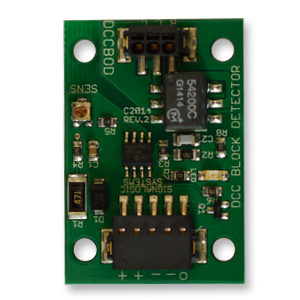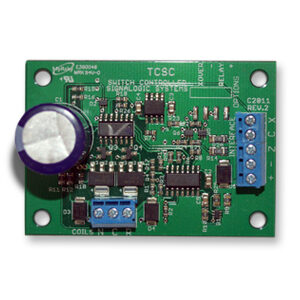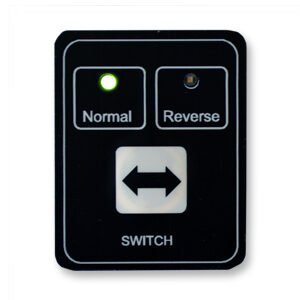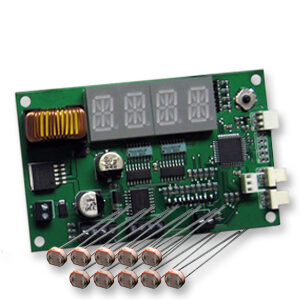Description
The DCCBD is a Digital Command Control (DCC) track occupancy detector for model railroads. This detector uses the current-detection method of determining train presence.
Prototypical Track Circuits
Current-detection allows the detection of trains similar to prototypical track circuits. Track circuits employ an electric current through the rails within a defined region. When no trains exist, the current slows as intended from one end of the track circuit to the other. When a train occupies the track-circuit, the metal wheels and axle divert, or shunt, the current from being able to flow across the entire track circuit. A fail-safe relay or other receiving device declares the presence of a train (occupancy) when the current is not received. Other failures such as broken wires to the track also result in a disruption of the current and thus allows a fail-safe response when a failure occurs.
Model Railroad Block Detection
In the model railway works, electric current is present on the rails to power our trains. Current-detectors use the sourced current as an indicator that a train is present. Rolling stock typically doesn’t have axles that draw power, so some axles are modified to draw some current to detect the train.
Model railroaders refer to current-detection as block detection, however current-detection more closely resembles track circuits, of which signal blocks are made up of. Track circuits also exist in sections such as within interlockings which are not part of a signal block at all.
DCCBD Features
The DCCBD can successfully detect trains with resistances up to 10 K Ohms. A continuous current of 5 A is possible through the DCCBD.
The module is powered from a 12 VDC power supply common to all other signal and control circuitry offered by Signalogic Systems. Duplicate terminals are provided to allow for daisy-chaining the power wiring between detector boards together.
Duplicate terminals are also provided for the DCC buss to allow for daisy-chaining of DCC buss energy to multiple DCCBDs mounted together.
The detector status is provided by a built-in LED that provided instantaneous indication of train detection. Detection output is provided with 3 seconds of LOS time to ensure occupancies remain prototypically solid, even with dirty wheelsets.
An open-collector output is provided, allowing for interfacing to detection applications such as:
-
-
- block signaling
- crossing warning systems
- staging yard detection.
-
The DCCBD is also available in a 10-pack.






Reviews
There are no reviews yet.